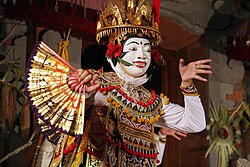| Poco-poco |
|---|
|
| Burma |
| Cambodia |
| Indonesia |
|
| Laos |
| Malaysia |
| Philippines |
| Singapore |
| Thailand |
|
| Vietnam |
Poco-poco or Poco poco is a popular line dance from North Maluku province in Indonesia.
Contents
The Poco-poco dance became popular in early 1998. In the beginning, the Poco-Poco dance was only an environment known for its emotional closeness with family, relatives, and relatives in North Maluku. This dance is accompanied by a song from North Maluku which is also titled poco-poco. The poco-poco song was composed by a native Indonesian Ternate songwriter named Arie Sapulette and sung by a famous singer at the time named Yopie Latul. The Poco-Poco dance has found its place in the hearts of the Indonesian people. Since its release, the song and/or accompanying dance has made its way into weddings, family gatherings, and other gatherings of Indonesian people.





